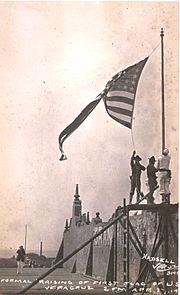
The flag being raised at Vera Cruz, 1914. From Wikipedia.
A hundred years ago, the wireless had unquestionably established itself as one of the tools of war. On this day in 1914, the Mexican Port of Veracruz was under American occupation after three days of fierce fighting under the command of Admiral Frank Friday Fletcher. The invasion was a response to the arrival of arms bound for Mexico City and “El Usurpador”, President Victoriano Huerta, who was subject to a U.S. arms embargo. The arms were originally thought to have been provided by the German government, but actually originated from the Remington Arms Company in the U.S. and had been sourced by American financier John Wesley De Kay.
The episode is an early case of the role that the wireless telegraph was now playing in war. In the early morning hours of April 21, the American Consul in Vera Cruz, William Canada, sent an urgent cable to Washington reporting that the German ship carrying the arms was in the harbor and its arrival was imminent. The cable reported that approach of the German vessel and the fact that locomotives and cars were ready to rush the arms to Mexico City. Secretary of State William Jennings Bryan received the cable at 4:00 in the morning and phoned President Wilson’s private secretary, Joseph Tumulty, who decided to awaken the President. Even though the White House servants were reluctant to do so, they agreed and the President came to the telephone.
At the same time, Navy Secretary Josephus Daniels phoned and was put on the same line. Daniels had received a wireless message from Admiral Fletcher that 250 machine guns along with 15 million rounds of ammunition would be landed from the vessel. The President listened in silence until Navy Secretary Daniels asked him “what shall we do?” “Tell Fletcher to seize the customs house” was the President’s reply. A few minutes later, a wireless was dispatched to Fletcher. He received the message at 10:00, and marines were on the ground an hour later.
You can read the wire reports in the Logan (Utah) Republican, where they appeared on April 25, 2014.
